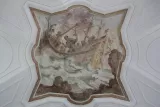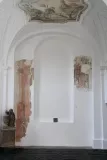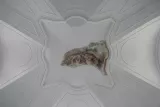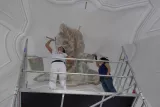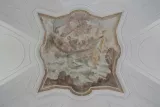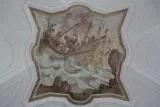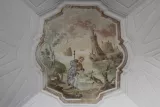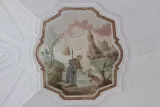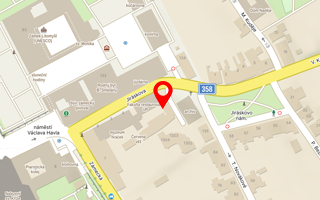Carried out by: BcA. Anežka Beranová, BcA. Jan Lhoták, BcA. Romana Rajtárová (1st-year students of the Master’s degree programme)
Teaching supervision: MgA. Zuzana Wichterlová, Mgr. art. Jan Vojtěchovský, Ph.D., MgA. Barbora Vařejková
The chapel is located in the building of the former Jesuit monastery. It was built in the Baroque style, most likely according to architect Carlo Lurago in 1714. A part of an illusive altar painting is preserved from the Baroque decoration. On the ceiling, the Baroque period is represented by a circular incision, suggesting there used to be a round stucco frame that could carry a canvas painting.
The second phase of the painted decoration is in the Rococo style, and it depicts miracles performed by St. Francis Xavier, a missionary and patron saint of seafarers. We do not know the accurate dating of the paintings, but they must have been executed by 1773 when Pope Clement XIV dissolved Jesuit monasteries. The rococo decoration was probably applied to the whole interior of the chapel. The scenes were executed by an unknown artist on a thick limewash by a secco technique. Around them, there are illusive gilded frames adorned with egg-and-dart.
The chapel served for various purposes later, e.g. a military hospital, garage or – after being divided by partitions – a private flat. Except of covering with a lime wash, there were no fundamental damages to the original painting. In 1997, the chapel interior was renovated. Based on the false conclusions of the 1996 survey, a part of the rococo decoration was removed from the walls and stucco. The ceiling painting of St. Francis Xavier and the crab in the presbytery was uncovered.
The ceiling painting St. Francis Xavier calms down a sea storm in the nave was uncovered in several phases. Secondary layers were removed from the altar; simultaneously, a part of rococo decoration was, perhaps accidentally taken off as well, which uncovered a painting of a similar shape from the Baroque period.
Following the survey of the whole interior, restoration treatment of the two ceiling rococo paintings commenced in 2016 – one of them was partially hidden under the stucco and washes and the other one uncovered. Both paintings were soiled with a layer of dust and biological deposits. Along the edges, the paintings were splashed with white paint. Gilded lines framing the egg-and-dart ornamentation oxidized and turned brown. Areas with smalt pigment partially lost their colour. The paintings in the nave carried biological growth in places, namely mould in the form of black spots. The paint layer was slightly powdering in particular areas. Plasters were detached in several places, mainly in the areas of cracks.
The treatment of the nave painting began with taking off the layers that covered the paintings. The removal was extremely demanding; it was carried out mechanically using a restoration-hammer and a scalpel. In the most sensitive areas, the paint layer was continuously pre-consolidated with acrylic dispersion K9. After the uncovering, the painting was again surveyed.
Both paintings were dry cleaned with Akapad sponges and treated with a Fungispray biocide. The splashes caused by spraying the interior were removed with cotton swabs and water. The paint layer was coated with a 0.5% (w. /w.) Medium für Konsolidierung acrylic dispersion all over the surface. Open defects in the plaster were consolidated with CaLoSil® E25 lime nanosuspension. The cavities in the plaster were grouted with Ledan TA1 mixed with marble powder. Significant cracks were filled with a fine-grained lime mortar. Tiny but plentiful losses of the paint layer meant the greatest and the most extensive damage. They were retouched by means of imitative retouching of lighter hues using mineral pigments and a 2 % (w. /w.) Arabic gum solution in water.
